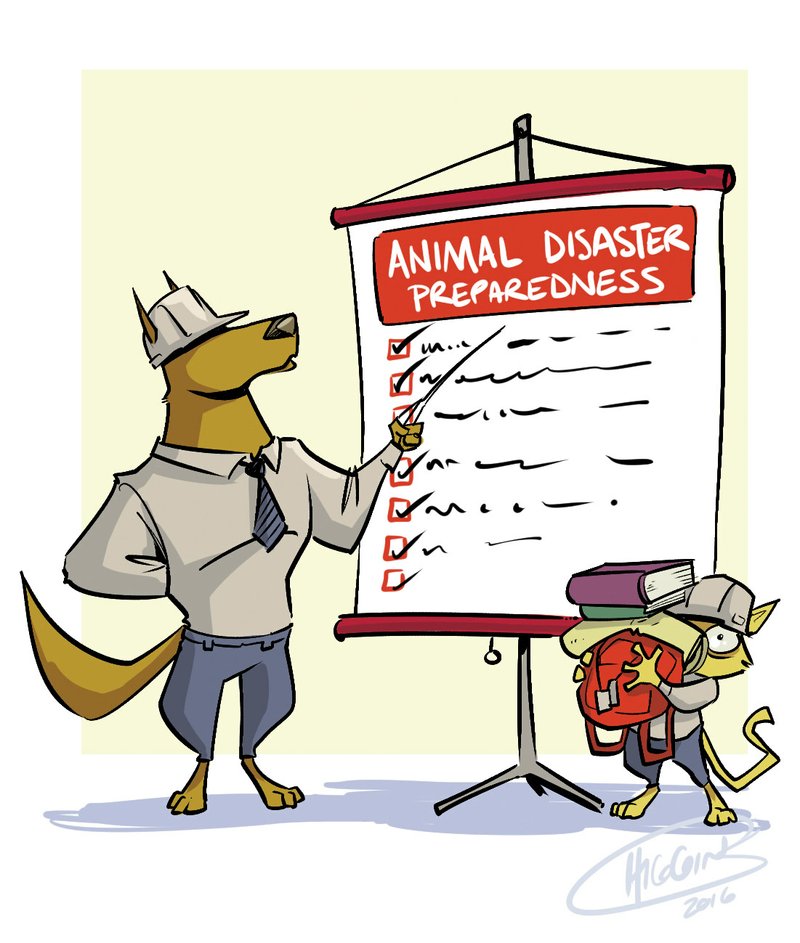Saturday is National Animal Disaster Preparedness Day, which has been designated to encourage people to keep their pets in mind when creating a family emergency plan.
A plan might cover what to do in case of a tornado or flood, as well as in emergencies such as house fires. A disaster can be anything that requires you to evacuate your home for any period of time. To help you prepare for the unexpected, here are some tips from the American Society for the Prevention of Cruelty to Animals and the Federal Emergency Management Agency.
Post a "pet rescue alert" sticker on or near the front door of your residency to let rescue workers know the type and number of pets that are in your household. Also include the name and phone number of your veterinarian. Stickers are available at most veterinary offices or can be ordered free at tinyurl.com/jam8ulv.
Make sure all of your pets have up-to-date identification and contact information on collars and tags. The ASPCA recommends microchipping pets as a more secure way of ensuring they can be identified in an emergency. A microchip embedded in a pet's shoulder area can be read by scanners at most animal shelters.
Keep pets indoors during severe weather. Plus, keep them near you at all times. If your pet gets nervous during storms, you may want to tether him to you with a leash or put him in his crate or carrier. Be sure the carrier or crate has your contact information on it also. Pets in crates have been found safe after tornadoes, but miles from home after being lifted up or blown from the home by the storm.
Designate havens inside your house, such as rooms that don't have windows. Also determine in advance where you might take your pet if you have to evacuate and are unable to keep him with you. Animal shelters tend to fill up during emergencies so consider arranging with friends and family outside your area to house your pet if necessary. If your veterinarian doesn't have a boarding facility, ask for a list of preferred kennels in your area.
Compile a list of motels and hotels outside your area that allow pets.
Emergencies aren't only natural disasters but might be something such as an unexpected hospital stay. To make sure your pet isn't left to fend for itself at home, choose temporary caregivers (neighbors, friends, relatives) and make sure they have keys to your house. Ideally, the caregiver will be someone who knows your pet, has a rapport with it and is familiar with its needs.
Keep a current list of your pet's medications, dietary requirements and any other special information on your smartphone so that you can text or email it to the person caring for your animal. Also post the information in the house in a place where a caregiver can easily find it.
Make a disaster kit that includes recent photos of your pet, photocopies of its medical information and a waterproof container with a supply of any medicine it takes (remember to rotate the medicine regularly so your kit doesn't contain expired drugs). Pack dry food or canned food along with a carrier, water and food bowls, and cage liners for use if your pet can't go outside to use the bathroom.
For dogs, the kit also should contain treats, toys and a leash. A cat kit needs to include treats, toys, scoopable litter and a disposable litter tray.
The ASPCA website provides preparedness advice for horse owners and people with reptiles, birds and other small pets at tinyurl.com/gwuvk6m. FEMA offers extensive information about what to do in all kinds of emergencies at ready.gov.
Family on 05/11/2016
